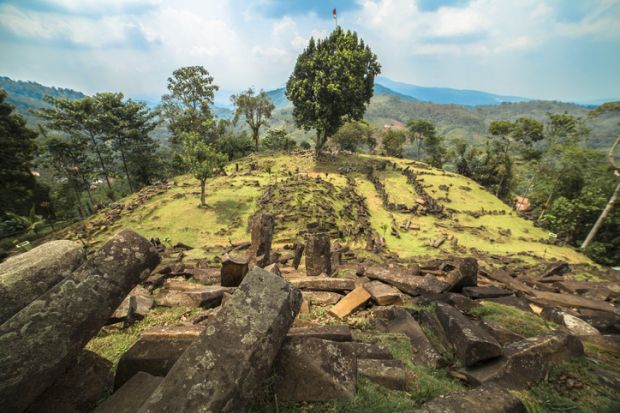A study that suggested that the world’s “oldest pyramid” was built in Indonesia more than 25,000 years ago has been retracted after a journal’s editors agreed that it contained a “major error”.
The withdrawal of the paper from the Wiley journal Archaeological Prospection follows criticism of its sensational claim that the deepest part of the Gunung Padang archaeological site near Jakarta showed signs of having been “sculpted” by humans up to 27,000 years ago before it was enveloped by glaciers during the Ice Age.
That claim, published in October, would have meant that the “pyramid” was the oldest man-made structure in the world by some distance: Turkey’s Göbekli Tepe temple is believed to be about 9,000 years old, while the Egyptian pyramids at Giza date back about 4,500 years – twice the age of the UK’s Stonehenge monument.
However, the study’s critics had suggested that its authors could not reliably carbon-date the Indonesian structure based solely on soil from drill samples taken from deep below Gunung Padang. Instead, the edifice should have been dated based on man-made artefacts taken from site, which suggest that it is only about 2,000 years old, they say.
Acknowledging what it called a “major error…not identified during peer review”, a retraction notice published on 19 March states that “the radiocarbon dating was applied to soil samples that were not associated with any artifacts or features that could be reliably interpreted as anthropogenic or ‘manmade’.
“Therefore, the interpretation that the site is an ancient pyramid built 9,000 or more years ago is incorrect, and the article must be retracted,” it concludes.
Responding to what he called the “unjust retraction of groundbreaking research”, the study’s lead author, Danny Hilman Natawidjaja, a geologist at the Indonesian Institute of Sciences, said the retraction was “solely based on unfounded claims raised by third parties who hold differing opinions and disbelieve in the evidence, analysis, and conclusions”.
Questions about the paper were also raised after Graham Hancock, a British journalist and film-maker, was thanked for proofreading the study. Mr Hancock visited the site for his popular Netflix show Ancient Apocalypse and claimed that it could provide evidence that, contrary to conventional belief, a sophisticated prehistoric civilisation existed before the Ice Age and might have brought its science and technology to different corners of the world.
Cardiff University archaeologist Flint Dibble, who has interviewed Lutfi Yondri and Harry Sofian, Indonesian experts who have excavated the site, for his YouTube channel, welcomed the retraction. It was important for editors to acknowledge that “they made a mistake for publishing papers that were so clearly lacking in evidence”, he said.
“Every archaeologist I know who read the Natawidjaja 2023 paper on Gunung Padang could immediately spot the fact that there was no evidence for the site being a pyramid nor any evidence that there was any human occupation at the site in the lower layers with such old, Ice Age dates,” said Dr Dibble.
Dr Yondri had noted, he continued, that “secure charcoal from archaeological contexts directly associated with the architecture on the site…date the monument to around 2,100 years ago”, adding that most experts agreed that it was not a “pyramid” but rather a “stone terrace” built into the side of a naturally occurring hill.
Register to continue
Why register?
- Registration is free and only takes a moment
- Once registered, you can read 3 articles a month
- Sign up for our newsletter
Subscribe
Or subscribe for unlimited access to:
- Unlimited access to news, views, insights & reviews
- Digital editions
- Digital access to THE’s university and college rankings analysis
Already registered or a current subscriber? Login











